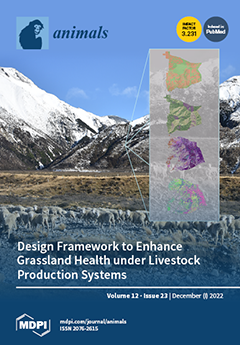To evaluate the effect of dietary level of beet pulp, with or without molasses, on growth performance, a total of 470 28-day-old rabbits were used (614 ± 6 g). Animals were randomly allocated into five dietary treatment groups: Control, without beet pulp; BP
[...] Read more.
To evaluate the effect of dietary level of beet pulp, with or without molasses, on growth performance, a total of 470 28-day-old rabbits were used (614 ± 6 g). Animals were randomly allocated into five dietary treatment groups: Control, without beet pulp; BP
20, and BP
40 with 20 and 40% of beet pulp without molasses, respectively; and BPM
20 and BPM
40, with 20 and 40% of beet pulp with molasses, respectively. Daily feed intake (DFI) and average daily gain (ADG) were controlled at 28, 49, and 59 days of age. Carcass and digestive tract traits were also determined at 59 days of age. Mortality and morbidity were controlled daily. Mortality during the growing period was higher in BPM than in BP groups (+9.2%;
p < 0.05). The higher the inclusion of beet pulp, the lower the DFI and ADG of animals (5.5 and 4.6% for every 20% inclusion, respectively;
p < 0.001), as well as the dressing out percentage, the liver proportion, and the dissectible fat percentage of their carcasses. However, the best feed efficiency during the last 10 days was obtained with the BPM
40 group. The higher the inclusion of beet pulp, the higher the weight of the empty gastrointestinal tract and cecum (+2.4 and +3.0 percentage points for every 20% inclusion, respectively;
p < 0.001). In fact, a higher inclusion of beet pulp decreased the pH and dry matter and decreased the total volatile fatty acids content of cecum richer in acetic acid but poorer in propionic, isobutiric, isovaleric, and valeric acids. Stomach weight was lower, and the capric acid content in the cecum was higher in the BPM than in the BP group. The inclusion of beet pulp in the feed reduced the growth performance and carcass yield of growing rabbits, and an even higher incidence of digestive disorders was observed when beet pulp included molasses.
Full article






